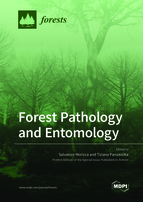Forest Pathology and Entomology
A special issue of Forests (ISSN 1999-4907). This special issue belongs to the section "Forest Ecology and Management".
Deadline for manuscript submissions: closed (30 June 2021) | Viewed by 57647
Special Issue Editors
Interests: tree pathology; ecology of invasive species; quarantine organisms; climate change impact; fungal endophytes; rust fungi; oomycetes; plant protection; biological control
Special Issues, Collections and Topics in MDPI journals
Interests: insect pests; bark beetles; insect pheromones; forest insects; invasive alien insects; saproxylic insects
Special Issues, Collections and Topics in MDPI journals
Special Issue Information
Dear Colleauges,
Forest protection has now become an important global priority. The arrival of new diseases and pests in uncontaminated territories and the resurgence of old, known agents of damage pose serious threats to trees in natural ecosystems as well as in urban forests, impacting ecosystem services. Climate change further exacerbates the problem, weakening forest trees and creating conditions for the range expansion of invasive diseases and pests. Furthermore, the growing trade of seedlings and other propagation material (seeds, cuttings, etc.) is boosting the spread of plant and animal parasites, seriously compromising forest and ornamental nursery activities. With the globalization of trade, the development of diagnostic tools for the early detection of latent pathogens and pests has become crucial. In this context, forest pathology and entomology have become more relevant than ever. We encourage studies from all these fields, including monitoring, epidemiology, ecology, diagnostics, and pest and disease management and control to contribute to this Special Issue to promote the dissemination of knowledge in forest protection for the preservation of structure, diversity, and resilience of natural and urban ecosystems.
Prof. Dr. Salvatore Moricca
Prof. Dr. Tiziana Panzavolta
Guest Editors
Manuscript Submission Information
Manuscripts should be submitted online at www.mdpi.com by registering and logging in to this website. Once you are registered, click here to go to the submission form. Manuscripts can be submitted until the deadline. All submissions that pass pre-check are peer-reviewed. Accepted papers will be published continuously in the journal (as soon as accepted) and will be listed together on the special issue website. Research articles, review articles as well as short communications are invited. For planned papers, a title and short abstract (about 100 words) can be sent to the Editorial Office for announcement on this website.
Submitted manuscripts should not have been published previously, nor be under consideration for publication elsewhere (except conference proceedings papers). All manuscripts are thoroughly refereed through a single-blind peer-review process. A guide for authors and other relevant information for submission of manuscripts is available on the Instructions for Authors page. Forests is an international peer-reviewed open access monthly journal published by MDPI.
Please visit the Instructions for Authors page before submitting a manuscript. The Article Processing Charge (APC) for publication in this open access journal is 2600 CHF (Swiss Francs). Submitted papers should be well formatted and use good English. Authors may use MDPI's English editing service prior to publication or during author revisions.
Keywords
- Disease and pest outbreaks
- Plant health
- Disturbances
- Global warming
- Biodiversity
- Ecosystem services
- Forest management






